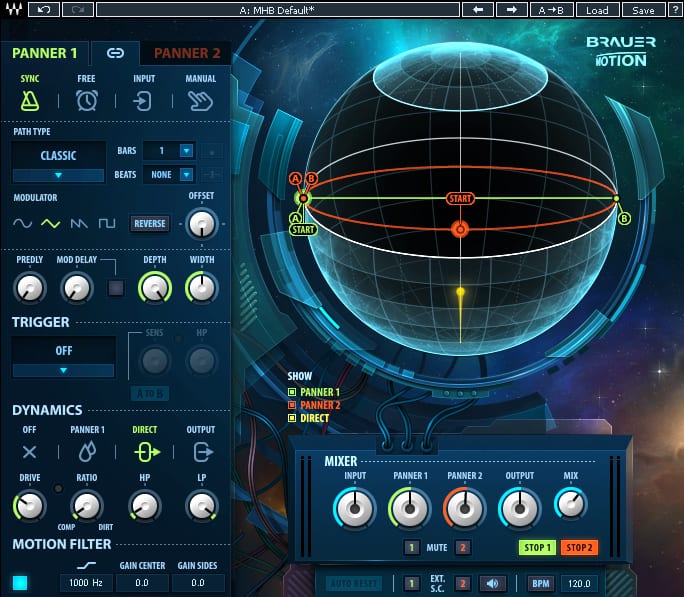New Gear Review: Brauer Motion from Waves
Michael Brauer has teamed up with Waves to create a new plugin that aims to take panning to the next level.
Based on the rare FS1 Cyclosonic panner from Songbird, a novel signal processor that could produce 360 degrees of panning using just two speakers, Brauer Motion represents the next generation of sophisticated panning tools—and then ups the ante by adding on some more generalized tone-shaping capabilities.
Let’s take a closer look:
Features

Waves have teamed up with GRAMMY Award winning mix engineer Michael Brauer to bring you the Brauer Motion plugin, a fresh new way to bring creative and unique movement to your tracks.
Brauer Motion provides two panners, each of which feed a stereo output.
Because some of its settings are level-dependent, this plugin is intended to be used as an insert on a single sound source.
Motion features options for ”Classic” Left/Right panning, ”Circular” panning, ”Circular with Phase”, and “X Lights”, inspired by railroad crossing warning lights.
The Classic and Circular modes both allow you to use modulators to control how the panner responds. There are controls for both Depth and Width, which allow you to easily alter the route and shape of panning, which is nicely displayed via an intuitive GUI.
The modulation of the panning can be set to Sync mode (following the session tempo), or Free mode (which makes it independent of session tempo), while the input responds to the envelope of the source signal.
By using of the “Width” control, you can expand a track’s placement outside and beyond the original width of its stereo image. “Depth” controls how far back and forward a pan can go (think circular vs. oval). The “Trigger” section provides multiple options for how the panners respond to the input signal. Triggers can be one-shot or continuous, and there is both a sensitivity adjustment and high pass filter.
Each panner, as well as both the direct and output signals, has a “Dynamics” section. Here, you’ll find controls for “Drive” and “Ratio”, which I found added a nice sounding grit that is reminiscent of harmonic distortion of the tube variety, even though it was inspired by early Akai samplers. The Dynamics section also features high and low pass filters, which come very much in handy.
Located just below the Dynamics section is the “Motion Filter” section. The cool factor here is that you can gain up or down the front and back paths of the pans, independent of one another. I found this to be extremely helpful with mix placement.
Finally, the “Mixer” section allows for level adjustments for all outputs, as well as Mute and ”Stop” buttons for the panners. External triggering is also available in this section.
In Use
Aside from the traditional parameters provided, Brauer Motion offers further control through a spherical representation of the sound field. This GUI looks very 21st century, and allows for manipulation of the pan path by grabbing the ”A” and “B” points for the panners and dragging them around.
When the plugin is set to Sync mode, having a basic knowledge of musical timing helps for controlling speed, as the length of the pan is represented in bars, beats, and other musical modifiers such as dotted and triplet notation.
Brauer Motion offers the unique ability to combine different pans for some truly interesting sounds. I was able to jump right in and create an awesome three-dimensional sound for a Wurlitzer track in minutes. With one panner somewhat centered, I set the other to sweep wider, which created an immersive effect that remained present while still having motion.
You would be remiss to gloss over the Drive and Ratio controls of the Dynamics section, as they provide some truly unique options for processing your sounds—regardless of panning. With little effort, I was able to make my Wurlitzer track feel thicker and more present, without getting tubby. In fact, I recently learned that Brauer himself is now using this section just for the signal processing alone.
To Be Critical
In line with the standard of excellence for which Brauer and Waves are both known, it’s clear that there was no shortage of creative and meticulous planning in the design of Brauer Motion. I can honestly say that I did not find it to be lacking in any of its features. Whether I was using the plugin for its intended purpose of creating unique space and movement, or simply to manipulate the signal regardless of panning, I found I was always satisfied with the results.
Summing it Up
GRAMMY-winner Michael Brauer is well-known for achieving great emotional impact in his mixes. With Brauer Motion, Waves provides one more unique and intriguing tool to help in your efforts to do the same.
Available for $99 (current sale price of $29), Brauer Motion is a unique and powerful tool that can deliver great results wherever you need to go beyond the conventional when it comes to panning and modulation effects.
[To learn more about how this plugin came together, visit the SonicScoop article “The Making of Brauer Motion”, featuring an in-depth interview on the creation process with Michael Brauer.]
Rick Slater is an audio professional who lives, works, and educates in the New York City area.
Please note: When you buy products through links on this page, we may earn an affiliate commission.






